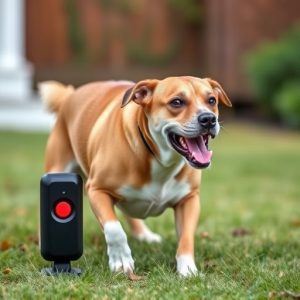Ultrasonic Frequency Tools for Dogs: Safety, Efficacy, and Effective Training
Dogs' behaviors, influenced by instincts and environment, demand careful consideration when int…….
Dogs' behaviors, influenced by instincts and environment, demand careful consideration when introducing tools like Electronic Pet Deterrents (EPDs). These devices use ultrasonic frequencies to trigger responses, aiming for positive training without harm. EPDs align with modern safety regulations, but their effectiveness varies among dogs due to individual sensitivity. Adhering to Electronic Pet Deterrent Safety Regulations is vital for responsible use, ensuring electromagnetic compatibility and animal welfare while promoting personalized training methods tailored to each dog's behavior patterns.
“Unleash the power of sound for dog behavior modification with ultrasonic frequency tools. This innovative technology offers a non-confrontational approach to training, leveraging high-frequency sounds invisible to humans but disruptive to dogs. Our article explores the science behind these devices, their effectiveness in shaping canine behavior, and crucial safety considerations within the regulatory framework of electronic pet deterrents. By weighing pros and cons, we guide owners through best practices for using ultrasonic frequency tools safely and effectively.”
- Understanding Dog Behavior and the Role of Ultrasonic Frequencies
- How Electronic Pet Deterrents Work and Their Efficacy in Training
- Safety Considerations and Regulatory Framework for Electronic Pet Products
- Evaluating the Pros and Cons of Ultrasonic Frequency Tools for Dog Behavior Modification
- Best Practices and Tips for Effective and Safe Use of Ultrasonic Dog Trainers
Understanding Dog Behavior and the Role of Ultrasonic Frequencies
Dogs, like humans, have unique behaviors shaped by their instincts and environment. Understanding these behaviors is crucial when introducing tools for modification, especially those using ultrasonic frequencies. This technology has gained traction as an Electronic Pet Deterrent (EPD), offering a non-confrontational approach to training pets. EPDs emit high-frequency sound waves that are generally inaudible to humans but can prompt specific responses from dogs, such as stopping barking or leaving a certain area.
The effectiveness of ultrasonic frequencies lies in their ability to provide immediate feedback without causing physical harm, aligning with modern safety regulations for pet deterrents. These devices are designed to stimulate specific behaviors through sound, leveraging the dog’s sensitivity to certain frequencies and tones. By targeting unwanted behaviors, EPDs can help train dogs while maintaining a positive relationship between pet and owner, making them a popular choice for responsible pet ownership in urban settings with strict noise regulations.
How Electronic Pet Deterrents Work and Their Efficacy in Training
Electronic pet deterrents, like ultrasonic frequency dog behavior modification tools, use sound waves to train and correct unwanted behaviors in dogs. These devices emit high-pitched frequencies that are usually inaudible to humans but can be detected by canines. When a dog exhibits problematic behavior, such as barking excessively or jumping on furniture, the deterrent activates, emitting an unpleasant sound that immediately stops the behavior. This method is non-violent and aims to associate certain actions with an uncomfortable sensation rather than physical punishment.
While these deterrents are widely available and advertised as effective, it’s crucial to consider their efficacy in light of Electronic Pet Deterrent Safety Regulations. Studies show mixed results regarding their success rate, with some dogs becoming accustomed to the sound over time, rendering them less effective. Additionally, not all dogs react to ultrasonic frequencies, suggesting a need for personalized training methods and an understanding of each dog’s unique behavior patterns.
Safety Considerations and Regulatory Framework for Electronic Pet Products
When considering electronic pet deterrents, such as ultrasonic frequency devices designed for behavior modification in dogs, it’s paramount to prioritize Electronic Pet Deterrent Safety Regulations. These products operate on high-frequency sound waves, which, while harmless to humans, can provoke strong reactions in canine senses. Therefore, thorough testing and certification by recognized authorities are essential to ensure the device’s safety and efficacy. Reputable manufacturers adhere to Safety Considerations outlined by relevant regulatory bodies, ensuring their products meet specific standards for electromagnetic compatibility, material safety, and overall animal welfare.
The Regulatory Framework for electronic pet products varies across regions, with some countries mandating specific labels, user instructions, and even clinical trials for certain types of devices. For instance, the US Food and Drug Administration (FDA) oversees pet products’ safety, while in Europe, the REACH (Registration, Evaluation, Authorization, and Restriction of Chemicals) regulation plays a pivotal role. Staying informed about these regulations not only ensures compliance but also allows pet owners to make informed decisions, understanding the potential benefits and limitations of ultrasonic frequency tools for behavior modification.
Evaluating the Pros and Cons of Ultrasonic Frequency Tools for Dog Behavior Modification
Ultrasonic frequency tools have gained popularity as a method for dog behavior modification, offering an alternative to traditional training methods. These devices emit high-frequency sound waves that are inaudible to humans but can be bothersome to dogs, encouraging them to alter their behavior. One of the primary advantages is their non-invasive nature; they do not involve physical punishment or negative reinforcement, making them potentially safer than some other deterrents. This makes them particularly appealing for owners seeking humane training solutions.
However, there are considerations regarding their effectiveness and safety under Electronic Pet Deterrent Safety Regulations. While some dogs may respond well to the sound, others might not be affected, rendering the tool less consistent. Moreover, improper use could lead to unexpected behaviors or even anxiety in dogs, highlighting the importance of adhering to guidelines and consulting professionals for optimal results.
Best Practices and Tips for Effective and Safe Use of Ultrasonic Dog Trainers
When using an ultrasonic dog trainer, adhering to best practices is essential for both effectiveness and safety. Always follow the manufacturer’s instructions precisely and ensure the device is suitable for your dog’s age, size, and breed. Start with lower settings and gradually increase the intensity as needed, monitoring your dog’s reaction closely. The goal is to provide a gentle reminder, not cause discomfort or fear. Avoid using it in situations that might trigger anxiety or during playtime. Regular breaks are crucial to prevent overstimulation.
Safety regulations for electronic pet deterrents, like ultrasonic trainers, vary by region. Research and comply with local laws to ensure responsible use. Keep the device out of reach of children and other pets. Regularly inspect the unit for any damage that could affect its safety or performance. If your dog shows no improvement or displays signs of distress, consult a professional trainer who specializes in positive reinforcement methods. Remember, consistency and patience are key when training your canine companion.
The ultrasonic frequency dog behavior modification tool presents a unique approach to training, leveraging electronic pet deterrents to guide canine behavior. While these tools have shown promise in modifying behaviors like barking and jumping, it’s crucial to consider both their pros and cons. In light of the ongoing debates around Electronic Pet Deterrent Safety Regulations, responsible use involves adhering to best practices and ensuring they complement positive reinforcement training methods. By understanding dog behavior, utilizing these devices safely, and staying informed about regulatory frameworks, pet owners can make informed decisions that foster healthier, happier canine-human relationships.


